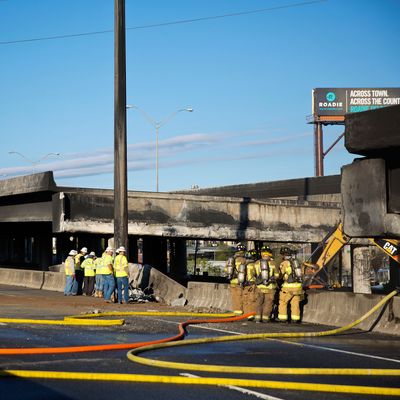
The bizarre fire and road/bridge collapse that has made I-85 impassable for an undefined but catastrophic period of time has drawn some national attention to Atlanta’s famously terrible traffic conditions, which are now going to get immensely worse. At Vox, Naomi Shavin does an admirable job of explaining the city’s transportation problems, particularly the stunted growth of the MARTA public-transit system. Here’s a key passage:
The metro area has a history of intentionally starving the public transportation system as an expression of segregation — affluent, predominantly white counties have long resisted connecting with public transit. Old news to locals, this reality made national headlines in 2014 when two inches of snow and a poorly timed weather dismissal strategy left thousands of Atlanta drivers stuck in traffic for hours.
Shavin is right, but there’s a piece of information she mentions elsewhere that some readers may not connect to the transit problem: Metro Atlanta is scattered across 29 counties, which has made it easy to confine public transit narrowly to the heavily African-American Fulton and Dekalb counties. Some of the insanely superfluous number of local jurisdictions is associated with recent population growth and sprawl, but it is all interconnected since the kind of land-use planning that might have created a more compact metro Atlanta is virtually impossible with so many jurisdictions.
The politics of Georgia’s 159 counties (second only to Texas, which has a far larger land area) goes way, way back. The legend is that Georgians decided in the 19th century that every farmer needed a county seat within a day’s commute and return via horse-drawn buggy. However it developed, the structure was frozen into place in 1917 via the adoption of Georgia’s unique “county unit” system for statewide elections. A sort of state version of the Electoral College without any basis in population equality, the county-unit system made it possible for rural politicians to run the state for decades with little or no input from the state’s urban areas. Since the system also coincided with the 20th-century version of Jim Crow, it basically enabled a very small group of conservative rural whites to control everything in Georgia. Obviously no small county was about to give up its unit votes and so consolidation was never an option.
The county-unit system was finally outlawed by the U.S. Supreme Court in 1963 in one of the landmark “one person one vote” rulings that required population-proportional districts for state legislatures. But the 159 counties lived on thanks to constitutional provisions that made consolidation politically impossible (though some largely rural counties have consolidated services across county lines). In the 1980s and 1990s, when I worked in the Georgia state government, there was a brief upsurge in interest in regional planning, especially in the Atlanta area, which needed it most. But with the advent of Republican rule in Georgia in the 21st century, “planning” has had a bad, socialistic aroma (conservative Republicans in Georgia were also heavily invested in the insane Agenda 21 conspiracy theory holding that development planning was part of a U.N. plot for world domination). Amidst that political climate, the Atlanta Metro Area has continued to sprawl with little opportunity for coordination, and the transportation system has never been able to catch up.
And so, a system created for farmers has helped create a great American city’s transportation nightmare. Go figure.






























